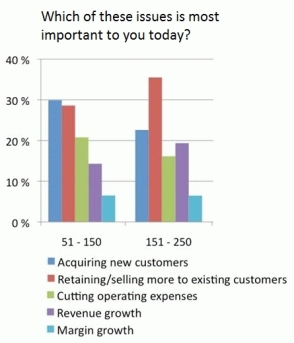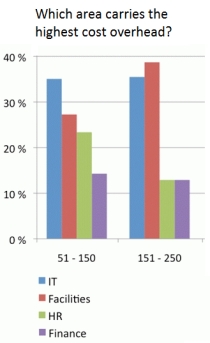May the Force.com be with you?
David Tebbutt rummages through some small business statistics and takes a peek at the Force.com application platform from Salesforce.
You may have heard of Salesforce.com, an online service that has been penetrating companies left, right and centre because a) it’s useful, b) it can be paid for by individuals and departments without ringing alarm bells in IT and finance and, c) because it can be slipped inside the company as a standalone application. With some justification it calls itself “the world’s most popular sales tool”. Its 55,000 customers are split about equally across small, medium and large enterprises.
Last week, it published some independent research findings among 1,000 UK SMBs which ostensibly pushed the importance of seeking new business. It defines SMBs as organisations of between 50 and 250 employees and the ‘new business’ seeking behaviour was most intense (at 60 percent) among companies of fewer than 50 staff – companies that shouldn’t have been included. However, while the remaining figures are not as dramatic, they’re still quite interesting. See how they match your reality (and comment if you feel so moved):

Important issues by number of employees (Q109)
The 51-150 (surely that should read 50-150) and 151-250 organisations broadly differ in their attitudes to getting new customers/selling to existing ones and in cost cutting versus revenue growth. All four things are important, of course, but each organisation has its own preferred strategies for getting through the present recession. About 28 percent of these same respondents said that they’d consider themselves successful if their businesses don’t shrink during 2009.
Turning to their cost burdens, you may be interested to see where they lie:

Areas of greatest cost overhead
Again, organisation size makes a difference, but not much. IT appears as something of a headache. And this, of course, is music to Salesforce.com’s ears.
As well as the original CRM service and a ‘service cloud‘, which I won’t bore you with here, Salesforce has a third string to its bow called Force.com which is an application platform.
This means that it provides somewhere to run your applications in the ‘cloud’ (no, don’t get me going), taking away from you all that horrible stuff like backup, restore, disaster recovery, reliability, hardware and delivering applications to connected users 24×7. Applications are easier to write (five times easier according to the blurb) and easier to implement. And you have no capital costs. An associated service, called AppExchange, provides many prewritten applications which could save you at least some development effort.
That’s the good news. The bad news is that it doesn’t excuse you from analysing your business processes, deciding what functions you need, writing and testing them (or finding them) and all the other activities that go into implementing business software. You will probably need to consider how such systems are going to work with those that are still running on your own equipment until, and if, you manage to outsource the whole lot.
UK Force.com user, Nimbus, got a 28 year old person with no IT skills (but, presumably, plenty of business analysis and Force.com skills) to do most of the work involved in migrating its home-grown applications, including spreadsheet macros and the like, out to Force.com.
Many companies might be interested in the idea of getting shot of their computing equipment and associated expenses. But, they are also probably concerned about their ability to do it, the cost of doing it and the danger that they won’t be able to get access to their systems if their broadband connection goes down or the Force.com platform goes off air. The last is probably the least of their worries. Salesforce is highly motivated to fix all problems of this nature very quickly. If it happens too often, it goes out of business. The company provide a ‘briefcase’ facility that allows people to continue working when they know they’ll be offline – travelling etc.
With respect to the other two issues: ability and cost, the first depends on your staff and their skills. But, it has to be said, sources of third party help for small businesses wanting to take the Force route are not exactly thick on the ground at the moment. Salesforce is aware of this.
And, since it represents a great opportunity for systems integrators and the like, I think it’s safe to say that this will change. The second, cost, means that you’d be moving capital expenditure to operational. So you could save big in the short term.
You will, however, incur implementation expenses, which wouldn’t be that different to moving to a different internal system. Then you will have your ongoing monthly costs for the service. These you have to hammer out with Salesforce.com and conduct your own ROI analysis. Its blurb reckons you’d halve your costs.
So, although IT is a large expenditure for SMBs, like all ‘cloud’ type solutions, Force.com is unlikely to prove a magic bullet. So much depends on your exact circumstances and your IT setup. But, equally, when reviewing your future computing options, it would make sense to keep it on your radar, not least because Salesforce itself is an established and reputable provider.
Share & Comment
Related Posts
SME News
- Entrepreneurs 2012 with President Bill Clinton 13-16 November
- IDCEE 2012. Internet Technologies and Innovations
- Nurturing the next generation of social entrepreneurs
- Get Britain Trading needs you
- Manufacturing gains, but economy fragile
- Minister to answer webcast questions on apprenticeships
- Staff beat £230 million a day cost of big freeze
 SME Blog
SME Blog
 0 comments
0 comments












Commenting Is Easy
Do you agree with this blog post? Disagree? Have something to add that others might find helpful? Then please leave a comment in the box below.
If you'd like to have your image included next to your comments here, then you can set yourself up with an avatar in just a couple of clicks.